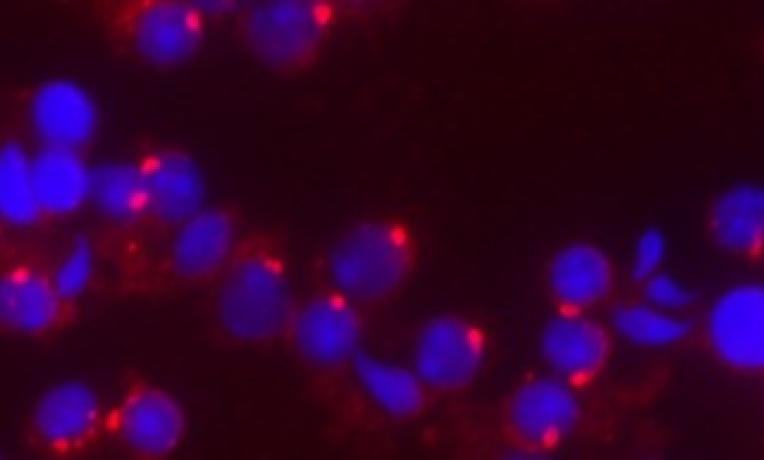Unveiling how our genome is protected
Conducting research in small RNAs, Dr. Ramesh Pillai attempts to understand how the genome protects itself from an internal threat, namely ‘transposons’ or ‘jumping genes’ which can cause mutations. Awarded an ERC Starting grant in 2010, Dr. Pillai is based at the European Molecular Biological Laboratory, Grenoble (France).

Every cell in our body uses small snippets of genetic material (called small RNAs) to identify and control the activity of specific members of more than 25,000 genes (constituting about 2% the human genome). 50% of our genome is host to sequences called “junk” - as they constitute repeated letters of the genetic code - unnecessary for the functioning of the cell. These sequences have a sinister potential, as some of them move about - removing themselves from one location and inserting into a new location in the genome.
Since 2003, researchers became aware of the existence of a special small RNA (called Piwi-interacting RNAs or piRNAs), and current studies are trying to understand their genesis and functioning. Dr Pillai’s research draws from protein biochemistry, computational biology, mouse genetics and cell biology - to explain how the genome defends itself against ‘transposons’ which threaten its integrity. He explains, "Our genome is populated by mobile alien DNA elements called ‘transposons’ or ‘jumping genes’ which can move freely within the cell, resulting in mutations. To locate and destroy such trouble-makers, the germ cells of all animals produce particular molecules called piRNAs. Animals lacking these defenders are infertile. My group is studying how these small defenders are generated, and how they function while protecting the genome."
Dr Pillai has shown that ‘Piwi’ - a protein in our genome that binds the small RNA - is a small RNA-guided enzyme (nuclease). Once the small RNA has identified transcripts (or DNA codes) from the target jumping genes, the Piwi protein destroys it by cutting it up. His group has shown that mice - which are genetically engineered to lack this activity - are infertile as a result of a failure to control transposons. His group has identified ‘partner’ proteins (‘tudor proteins’) that team up with Piwis to combat jumping genes by birthing new piRNAs. Research reveals that tudor proteins distinguish Piwis (from thousands of other proteins) by reading out specific chemical modifications on Piwis. The team studies whether the formation of this protein complex can be regulated, thereby making the path taken by the Piwi-interacting RNA (or piRNA) to the targeted DNA more responsive to the requirements of cells. Current efforts are aimed at understanding other components needed for the cell to produce piRNAs. His laboratory uses next-generation sequencing techniques and collaborates with biologists in understanding this machinery. One of their goals is to discover how the cell passes on the tricks it learned in taming transposons on to the next generation. It is hoped that this research will have future potential benefits in biotechnology, as any ability to manipulate our genome can be applied to the cure of genetic diseases.
For Dr Pillai, “Every researcher aspires to an ERC grant as it is indicative of high-quality research. With secured and substantial funding, we can focus on science. The prestige attached to the grant provides visibility within the scientific community, useful for establishing research contacts.” He collaborates with scientists across the globe in mouse genetics, and bioinformatics, besides engaging with other ERC grant-holders who use mice as models in their RNA research. He says, “The ERC provides a high level of funding, for investing well in infrastructure, for covering high costs of interdisciplinary scientific methods, and for establishing fairly large research groups. For early researchers, the grants are a pathway to independence.” More importantly, the ERC grant has given him the possibility of hiring a specialised team. Originally hailing from India, Dr. Pillai leads a highly diverse and international team, with members from Asia, Europe, North and South America and Australia. “I encourage my team to do good science. I advise those I mentor to pursue research as a career and some of my team members may go on to apply for an ERC grant in the future.”
On the importance of the ERC in an Indian context, Dr Pillai comments, “The ERC is a facilitator of creative ideas and its funding acts as a magnet for researchers to come to Europe. It offers young scientists from countries such as India the chance to benefit from excellent scientific facilities and to be part of the European research experience”.
Amongst the very first Indian researchers to receive an ERC grant, Dr Pillai was awarded his MSc in Biotechnology in India and received his PhD in Switzerland where he also got a post-doctoral fellowship at the Friederich Miescher Institute.


